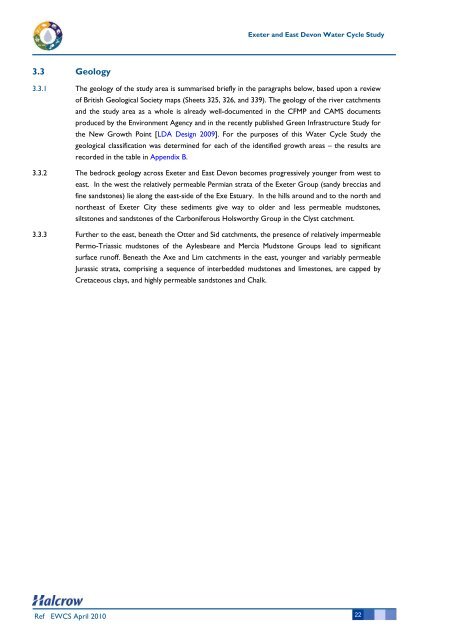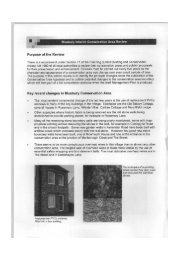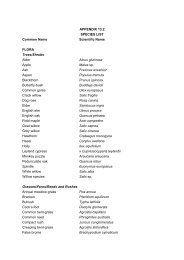Water Cycle Study - East Devon District Council
Water Cycle Study - East Devon District Council
Water Cycle Study - East Devon District Council
You also want an ePaper? Increase the reach of your titles
YUMPU automatically turns print PDFs into web optimized ePapers that Google loves.
3.3 Geology<br />
Ref EWCS April 2010<br />
Exeter and <strong>East</strong> <strong>Devon</strong> <strong>Water</strong> <strong>Cycle</strong> <strong>Study</strong><br />
3.3.1 The geology of the study area is summarised briefly in the paragraphs below, based upon a review<br />
of British Geological Society maps (Sheets 325, 326, and 339). The geology of the river catchments<br />
and the study area as a whole is already well-documented in the CFMP and CAMS documents<br />
produced by the Environment Agency and in the recently published Green Infrastructure <strong>Study</strong> for<br />
the New Growth Point [LDA Design 2009]. For the purposes of this <strong>Water</strong> <strong>Cycle</strong> <strong>Study</strong> the<br />
geological classification was determined for each of the identified growth areas – the results are<br />
recorded in the table in Appendix B.<br />
3.3.2 The bedrock geology across Exeter and <strong>East</strong> <strong>Devon</strong> becomes progressively younger from west to<br />
east. In the west the relatively permeable Permian strata of the Exeter Group (sandy breccias and<br />
fine sandstones) lie along the east-side of the Exe Estuary. In the hills around and to the north and<br />
northeast of Exeter City these sediments give way to older and less permeable mudstones,<br />
siltstones and sandstones of the Carboniferous Holsworthy Group in the Clyst catchment.<br />
3.3.3 Further to the east, beneath the Otter and Sid catchments, the presence of relatively impermeable<br />
Permo-Triassic mudstones of the Aylesbeare and Mercia Mudstone Groups lead to significant<br />
surface runoff. Beneath the Axe and Lim catchments in the east, younger and variably permeable<br />
Jurassic strata, comprising a sequence of interbedded mudstones and limestones, are capped by<br />
Cretaceous clays, and highly permeable sandstones and Chalk.<br />
22
















